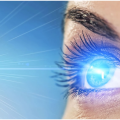The eye occupies less than 2% of the human body, but it is the only organ that allows the penetration of visible light deep into it. During the evolution of man, several mechanisms have been put in place to protect this very sensitive organ from the harmful effects of the sun’s rays.
Anatomically, the eye is recessed into the head and protected by the brow bone, eyebrows, and eyelashes. However, these anatomical adaptations are of limited value in protecting against UV in extreme conditions such as tanning beds or strong ground reflection due to snow, water, and sand.
Contraction of the pupil, closing of the eyelids and reflex strabismus minimize the penetration of solar rays into the eye. These mechanisms are activated by bright visible light, not UV radiation – and on cloudy days UV radiation exposure can still be high. This is why the effectiveness of these natural defenses to protect against UV damage remains limited.
Effects on Eyes
As with skin effects, the various solar rays penetrate the eye at different depths. While UVB rays are fully absorbed by the cornea, UVA rays pass through these superficial layers to the lens.
In adults, less than 1% of UV radiation reaches the retina due to the filtering function played by the cornea and the lens. In contrast, visible light easily penetrates the retina, where it activates photoreceptors and triggers the chain reaction of biochemical processes resulting in the production of a visible image.

Photokeratitis and Photo Conjunctivitis
Photokeratitis is an inflammation of the cornea, while photo conjunctivitis is an inflammation of the conjunctiva, that is to say, the membrane that lines the deep surface of the eyelids and the anterior surface of the eyeball.
These inflammatory reactions can be compared to a sunburn on the extremely sensitive tissues of the eyeball and eyelids, which appear within a few hours of exposure. Photokeratitis and photo conjunctivitis can be very painful, but they are reversible and do not appear to cause long-term eye damage or vision impairment.
Snow blindness is an extreme form of photokeratitis. It sometimes affects skiers or mountaineers subjected to a powerful intensity of UV radiation, due to the high altitude and very strong reverberation on the ground – fresh snow can reflect up to 80% of incident UV radiation. These extreme values of UV radiation kill the outer cells of the eyeball, resulting in blindness.
Snow blindness is very painful at the time of shedding dead cells. In most cases, new cells grow quickly and vision is restored within days. Very severe snow blindness can have complications such as chronic irritation or tears.
Pterygium
This conjunctival veil on the surface of the eye is a common cosmetic defect, probably related to prolonged UV exposure. The Pterygium can extend to the center of the cornea and thus reduce vision. It also tends to ignite. Although surgical removal is possible, it tends to reform.
Cataract
Cataract is the main reason for increasing cases of blindness across the globe. Lens proteins unravel, tangle, and accumulate pigment, obscuring the lens and ultimately leading to blindness.
Even if the cataract appears to vary in degrees in most subjects as they age, it seems that its development is favored by exposure to UVB rays. The treatment of cataracts involves the insertion of an artificial lens or an optical correction for restoring vision.
According to JLR Eye Hospital, nearly 40-45 million people worldwide are suffering from blindness due to the clouding of the lens. WHO estimates suggest that up to 20% of cataracts could be due to overexposure to UV and are therefore preventable.
Eye Cancer
Current scientific data suggests that different forms of eye cancer may be associated with lifetime sun exposure. Melanoma is the most common malignant cancer of the eyeball and sometimes requires surgical excision. Basal cell carcinoma of the skin is frequently found in the eyelids.
UV rays also affect our immune system and skin largely and their effects can be severe at times.
Effects on the Skin
UVA rays activate melanin, a pigment already present in the surface cells of the skin. They create a tan that comes on quickly but also sheds quickly. In addition, UVA rays penetrate the deeper layers of the skin where they affect connective tissue and blood vessels: the skin gradually loses its elasticity and begins to wrinkle.
Thus, significant exposure to UVA causes premature aging of the skin. In addition, recent studies strongly suggest that it could promote the appearance of skin cancer.
The UVB rays are responsible for the browning and thickening of the superficial layers of the skin – reactions that constitute the body’s defense mechanism against UV rays.
However, higher UVB doses cause sunburn, which increases the likelihood of one-day getting cancer.
The Immune System
UV radiation is thought to be absorbed by a molecule located in the skin. This leads to changes in the distribution and activity of some of the key molecular and cellular players in the immune system: a change in the balance of cell-mediated or humoral immune responses could reduce the body’s ability to defend itself against certain diseases.
Beneficial Effects of UV Rays on Our Health
The sun’s rays generate heat and light which reinforce the general feeling of well-being and stimulate blood circulation. A little UV radiation is essential for the body because it stimulates the production of vitamin D.
This has an important role since it increases the absorption of calcium and phosphorus present in food and plays a decisive role in skeletal development, immune function, and formation of formed blood elements. There is no doubt that a little sunlight is good for your health!
So, five to fifteen minutes of occasional sun exposure to the hands, face, and arms two or three times a week during the summer months is enough to keep vitamin D levels high, because of this for most people, near the equator, where UV intensity is higher, vitamin D deficiency is unlikely.
Possible exceptions are people who have extremely limited exposure to the sun, such as elderly people who no longer go out, or people with highly pigmented skin who live in countries at high latitudes where UV intensity is relatively low.
Conclusion
UV radiation has been successfully used to treat several diseases including rickets, psoriasis, eczema, and jaundice. This therapeutic use cannot erase the negative side effects of UV, but these treatments take place under medical supervision to ensure that the benefits they present outweigh the risks they pose such as eye damage and adverse effects on the immune system so precaution from UV rays is needed for sure.













